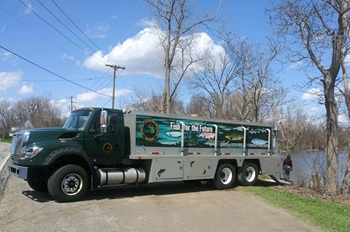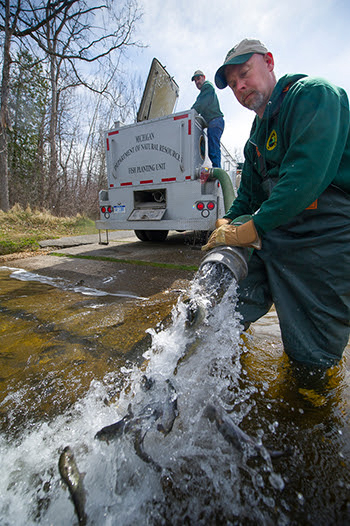Have Fish, Will Travel: Creating Fishing Opportunities Statewide

Have you seen fish stocking trucks on the road this spring? If not, chances are you soon will! Our stocking season is underway, and this time of year you’ll find DNR trucks releasing their prized cargo at hundreds of lakes and streams throughout the state.
Fish stocking is a valuable tool fisheries managers use for different reasons, including:
- Restoring ecosystem balance.
- Providing diverse fishing opportunities.
- Rehabilitating low fish populations.
- Reintroducing extirpated (locally extinct) species.
The DNR does not stock on top of wild populations when it can be avoided. Fish production staff members take great pride in the quality of the fish they produce, but when feasible prefer to rely on naturally reproducing fish that are adapted to their local ecosystem.
“Sometimes, the combination of angling pressure – sustained fishing – and habitat limitations in some areas will keep wild fish from maintaining the desired population level on their own,” said Aaron Switzer, DNR fish production manager. “In those instances, we’ll stock hatchery fish to supplement natural reproduction.”
The DNR accomplishes this work by rearing fish at its six fish production facilities throughout the state, cooperatively managing up to 29 rearing ponds and six Great Lakes imprinting net pen/pond locations (which help developing fish return to spawning waters when mature) and maintaining a fleet of 17 specialized fish stocking vehicles.
DNR crews stock more than 20 million fish – that’s over 350 tons – every year. Species include steelhead; lake sturgeon; Atlantic, Chinook and coho salmon; splake (a hybrid between lake trout and brook trout); and brown, brook, lake and rainbow trout, as well as muskellunge and walleye. Beginning in mid-March and ending in early June, DNR fish stocking trucks travel well over 100,000 miles to stock more than a thousand locations.
People often wonder where and why fish are stocked in a particular lake or stream – in fact, it’s one of the DNR’s most frequently asked questions. Some of the determining factors include a body of water’s current habitat, available forage fish and the concentration of predators and/or competitors.
If you’d like to see whether fish have been stocked in your favorite spots, visit michigandnr.com/fishstock.





